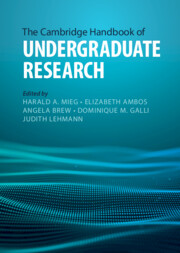Book contents
- The Cambridge Handbook of Undergraduate Research
- The Cambridge Handbook of Undergraduate Research
- Copyright page
- Contents
- Figures
- Tables
- Contributors
- Foreword
- Foreword
- 1 Introduction
- Part I Theory and Research on Undergraduate Research
- Part II Implementation, Approaches, Methods
- Part III Disciplines
- 17 Introduction
- Part III.1 STEM
- Part III.2 Health
- 24 Undergraduate Research in Medicine
- 25 Undergraduate Research in Health Sciences
- 26 Undergraduate Research in Nursing
- 27 Undergraduate Research in the Exercise Science Discipline
- Part III.3 Social Sciences
- Part III.4 Humanities
- Part III.5 Arts & Design
- Part III.6 Disciplines A–Z
- Part IV International Perspective
- Part V Avenues for Developing Undergraduate Research
- Index
- References
27 - Undergraduate Research in the Exercise Science Discipline
from Part III.2 - Health
Published online by Cambridge University Press: 11 August 2022
- The Cambridge Handbook of Undergraduate Research
- The Cambridge Handbook of Undergraduate Research
- Copyright page
- Contents
- Figures
- Tables
- Contributors
- Foreword
- Foreword
- 1 Introduction
- Part I Theory and Research on Undergraduate Research
- Part II Implementation, Approaches, Methods
- Part III Disciplines
- 17 Introduction
- Part III.1 STEM
- Part III.2 Health
- 24 Undergraduate Research in Medicine
- 25 Undergraduate Research in Health Sciences
- 26 Undergraduate Research in Nursing
- 27 Undergraduate Research in the Exercise Science Discipline
- Part III.3 Social Sciences
- Part III.4 Humanities
- Part III.5 Arts & Design
- Part III.6 Disciplines A–Z
- Part IV International Perspective
- Part V Avenues for Developing Undergraduate Research
- Index
- References
Summary
Exercise science is a multifaceted discipline with roots in many different natural science backgrounds.Most concepts associated with it can be made accessible and understandable to the most novice researcher. Students are exposed to knowledge relating to the discipline in the news, at school, during recreational sports, and in general dinner table conversation. This tends to make exercise science research less intimidating and more appealing to students of all backgrounds and majors than traditional sciences such as chemistry and biology. Even though this type of research can include complicated instrumentation that requires extensive training to operate, there are always aspects that benefit from undergraduate participation. In turn, exercise science investigations offer undergraduate researchers a level of accomplishment and responsibility that will directly impact future career aspirations.
Keywords
- Type
- Chapter
- Information
- The Cambridge Handbook of Undergraduate Research , pp. 267 - 274Publisher: Cambridge University PressPrint publication year: 2022

